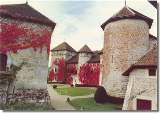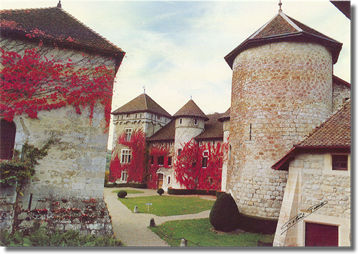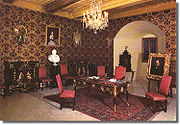
Château de Thorens
Encyclopedia
The Château de Thorens is a castle in the commune of Thorens-Glières
in the Haute-Savoie
département of France
. It is accessible from the north-east of Annecy
by a road of about 20 km, going up to the plateau of Glières. It is often confused with the Château de Sales
that was formerly its neighbour of a few hundred metres; Sales was destroyed on the order of king Louis XII in 1630. Since the liberation of France at the end of World War II
, the castle has sometimes incorrectly been called Château de Thorens-Glières, based on the current name of the commune, but it has always rightly been just de Thorens.
 The castle was confiscated by the duke of Savoie
The castle was confiscated by the duke of Savoie
in 1479. Many crimes, abuses and executions were reported to have been committed by the lords of Compey, so the castle was offered of Hélène de Luxembourg, spouse of prince Janus de Savoie, duke of Genève. Hélène was, however, not interested in Thorens; her daughter Louise de Savoie, who married her cousin François de Luxembourg, inherited the Château de Thorens.
Later, in 1559, Thorens was sold to Sébastien II de Luxembourg and Lord François de Sales de Boisy, father of Saint François de Sales
. The Lord de Sales already owned the Château de Sales
, located a few hundred metres from the Château de Thorens. Pledged also to the lords of Compey, initially, the Château de Sales thus came to the keeping of the princes of Luxembourg. The Lord de Sales occupied the prestigious charge of maître d'hôtel of the residence of prince Sébastien II. In the 17th century, the family of Sales, originating from La Roche-sur-Foron
and extremely old, saw a fast rise, occupying the highest charges at the House of Savoy
in Turin
, going from the titles of baron to those of count and, finally, marquis.
Abused during the French invasion of Savoy in 1792, the Château de Thorens was restored in the 19th century by the marquise Alexandrine de Sales, helped by her grandson, count Eugène de Roussy de Sales. Today, the family of Roussy de Sales, headed by Félix-Léonard de Roussy de Sales, inhabits the castle year-round and undertakes its preservation.
 The castle relates the life of Saint François de Sales
The castle relates the life of Saint François de Sales
and the family de Sales. Saint François de Sales (1567–1622), prince-bishop of Geneva, was a multi-faceted character eminently famous for his humility. His life is illustrated by liturgical goldwork, seals, episcopal clothes, paintings, documents and rare books.
The count Camille Benso de Cavour (1810–1861) is another character inextricably linked with Thorens; he stayed regularly in the castle with his cousins. When he was a prime minister for the Kingdom of Piémont-Sardaigne
, Camille de Cavour concluded the risorgimento to the profit of the Savoy House, with the aid of his old friend, the emperor Napoleon III. Consequently, the county of Nice
and the duchy of Savoy were annexed by France in the spring of 1860 by the Treaty of Annexation of March 24 . The Château de Thorens contains the personal effects of this statesman, his furniture, and his works of art; in particular, the sumptuous desk in the style of "Boulle Napoléon III" on which was signed the Treaty of Annexation.
Passing through the works of art, Flandres tapestries, masterpieces of paintings, and the furniture of the Renaissance
, the Baroque
period, and the Second French Empire
, the visitor finally enters the heart of the castle. This residence of the nobility, illuminated with the golden light of a salon, shows the finesse of 17th century tastes. The arched kitchen (1632) gives a hint of the feasts that filled this period. The austere arched rooms of the inner fortifications evoke the life of men-at-arms, and the keep recalls the seigniorial justice system.
The visit includes the keep, the staff waiting rooms of the 12th and 13th centuries, the kitchen with its imposing chimneys, the living rooms, the salons, and the offices richly furnished and decorated with works gathered from the time of the Italian Renaissance to Napoleon III. The garden also forms a part of the protected monuments.
Thorens-Glières
Thorens-Glières is a commune in the Haute-Savoie department in the Rhône-Alpes region in south-eastern France, and is the birthplace of St. Francis de Sales.-References:*...
in the Haute-Savoie
Haute-Savoie
Haute-Savoie is a French department in the Rhône-Alpes region of eastern France. It borders both Switzerland and Italy. The capital is Annecy. To the north is Lake Geneva and Switzerland; to the south and southeast are the Mont Blanc and Aravis mountain ranges and the French entrance to the Mont...
département of France
France
The French Republic , The French Republic , The French Republic , (commonly known as France , is a unitary semi-presidential republic in Western Europe with several overseas territories and islands located on other continents and in the Indian, Pacific, and Atlantic oceans. Metropolitan France...
. It is accessible from the north-east of Annecy
Annecy
Annecy is a commune in the Haute-Savoie department in the Rhône-Alpes region in south-eastern France.It lies on the northern tip of Lake Annecy , 35 kilometres south of Geneva.-Administration:...
by a road of about 20 km, going up to the plateau of Glières. It is often confused with the Château de Sales
Château de Sales
The Château de Sales is a ruined castle in the commune of Thorens-Glières in the Haute-Savoie département of France. It is often confused with the nearby Château de Thorens.-History:...
that was formerly its neighbour of a few hundred metres; Sales was destroyed on the order of king Louis XII in 1630. Since the liberation of France at the end of World War II
World War II
World War II, or the Second World War , was a global conflict lasting from 1939 to 1945, involving most of the world's nations—including all of the great powers—eventually forming two opposing military alliances: the Allies and the Axis...
, the castle has sometimes incorrectly been called Château de Thorens-Glières, based on the current name of the commune, but it has always rightly been just de Thorens.
History
At the exit of the village of Thorens-Glières, on the road of the famous plateau of Glières, the castle appears in proud silhouette in a beautiful mountainous setting. It is built on an ancient fort dating to 1060, built by the order of count Gérold de Genève, who bestowed it upon his faithful comrade in arms, Lord Odon de Compey.
Savoie
Savoie is a French department located in the Rhône-Alpes region in the French Alps.Together with the Haute-Savoie, Savoie is one of the two departments of the historic region of Savoy that was annexed by France on June 14, 1860, following the signature of the Treaty of Turin on March 24, 1860...
in 1479. Many crimes, abuses and executions were reported to have been committed by the lords of Compey, so the castle was offered of Hélène de Luxembourg, spouse of prince Janus de Savoie, duke of Genève. Hélène was, however, not interested in Thorens; her daughter Louise de Savoie, who married her cousin François de Luxembourg, inherited the Château de Thorens.
Later, in 1559, Thorens was sold to Sébastien II de Luxembourg and Lord François de Sales de Boisy, father of Saint François de Sales
Francis de Sales
Francis de Sales was Bishop of Geneva and is a Roman Catholic saint. He worked to convert Protestants back to Catholicism, and was an accomplished preacher...
. The Lord de Sales already owned the Château de Sales
Château de Sales
The Château de Sales is a ruined castle in the commune of Thorens-Glières in the Haute-Savoie département of France. It is often confused with the nearby Château de Thorens.-History:...
, located a few hundred metres from the Château de Thorens. Pledged also to the lords of Compey, initially, the Château de Sales thus came to the keeping of the princes of Luxembourg. The Lord de Sales occupied the prestigious charge of maître d'hôtel of the residence of prince Sébastien II. In the 17th century, the family of Sales, originating from La Roche-sur-Foron
La Roche-sur-Foron
La Roche-sur-Foron is a commune in the Haute-Savoie department in the Rhône-Alpes region in south-eastern France.-References:*...
and extremely old, saw a fast rise, occupying the highest charges at the House of Savoy
House of Savoy
The House of Savoy was formed in the early 11th century in the historical Savoy region. Through gradual expansion, it grew from ruling a small county in that region to eventually rule the Kingdom of Italy from 1861 until the end of World War II, king of Croatia and King of Armenia...
in Turin
Turin
Turin is a city and major business and cultural centre in northern Italy, capital of the Piedmont region, located mainly on the left bank of the Po River and surrounded by the Alpine arch. The population of the city proper is 909,193 while the population of the urban area is estimated by Eurostat...
, going from the titles of baron to those of count and, finally, marquis.
Abused during the French invasion of Savoy in 1792, the Château de Thorens was restored in the 19th century by the marquise Alexandrine de Sales, helped by her grandson, count Eugène de Roussy de Sales. Today, the family of Roussy de Sales, headed by Félix-Léonard de Roussy de Sales, inhabits the castle year-round and undertakes its preservation.

Francis de Sales
Francis de Sales was Bishop of Geneva and is a Roman Catholic saint. He worked to convert Protestants back to Catholicism, and was an accomplished preacher...
and the family de Sales. Saint François de Sales (1567–1622), prince-bishop of Geneva, was a multi-faceted character eminently famous for his humility. His life is illustrated by liturgical goldwork, seals, episcopal clothes, paintings, documents and rare books.
The count Camille Benso de Cavour (1810–1861) is another character inextricably linked with Thorens; he stayed regularly in the castle with his cousins. When he was a prime minister for the Kingdom of Piémont-Sardaigne
Kingdom of Sardinia
The Kingdom of Sardinia consisted of the island of Sardinia first as a part of the Crown of Aragon and subsequently the Spanish Empire , and second as a part of the composite state of the House of Savoy . Its capital was originally Cagliari, in the south of the island, and later Turin, on the...
, Camille de Cavour concluded the risorgimento to the profit of the Savoy House, with the aid of his old friend, the emperor Napoleon III. Consequently, the county of Nice
County of Nice
The County of Nice or Niçard Country is a historical region of France, located in the south-eastern part, around the city of Nice.-History:Its territory lies between the Mediterranean Sea , Var River and the southernmost crest of the...
and the duchy of Savoy were annexed by France in the spring of 1860 by the Treaty of Annexation of March 24 . The Château de Thorens contains the personal effects of this statesman, his furniture, and his works of art; in particular, the sumptuous desk in the style of "Boulle Napoléon III" on which was signed the Treaty of Annexation.
Passing through the works of art, Flandres tapestries, masterpieces of paintings, and the furniture of the Renaissance
Renaissance
The Renaissance was a cultural movement that spanned roughly the 14th to the 17th century, beginning in Italy in the Late Middle Ages and later spreading to the rest of Europe. The term is also used more loosely to refer to the historical era, but since the changes of the Renaissance were not...
, the Baroque
Baroque
The Baroque is a period and the style that used exaggerated motion and clear, easily interpreted detail to produce drama, tension, exuberance, and grandeur in sculpture, painting, literature, dance, and music...
period, and the Second French Empire
Second French Empire
The Second French Empire or French Empire was the Imperial Bonapartist regime of Napoleon III from 1852 to 1870, between the Second Republic and the Third Republic, in France.-Rule of Napoleon III:...
, the visitor finally enters the heart of the castle. This residence of the nobility, illuminated with the golden light of a salon, shows the finesse of 17th century tastes. The arched kitchen (1632) gives a hint of the feasts that filled this period. The austere arched rooms of the inner fortifications evoke the life of men-at-arms, and the keep recalls the seigniorial justice system.
Tourism
The Château de Thorens can be visited- From April 1 to June 30: Saturdays, Sundays, and public holidays from 14:00 to 18:00 hours, for individual visitors;
- From September 1 to October 31: Saturdays and Sundays from 14:00 to 18:00 hours, for individual visitors;
- From July 1 to August 31: every day from 14:00 to 19:00 hours, for individual visitors;
- All the year for groups, excepted December 25 and January 1 (reservations needed).
The visit includes the keep, the staff waiting rooms of the 12th and 13th centuries, the kitchen with its imposing chimneys, the living rooms, the salons, and the offices richly furnished and decorated with works gathered from the time of the Italian Renaissance to Napoleon III. The garden also forms a part of the protected monuments.

